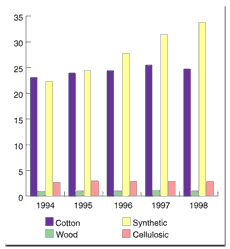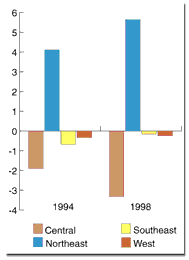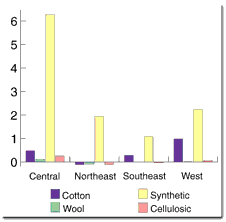Asian Fiber IndustryBy John E. Luke Expansion Strategy
Asian nations are now in the drivers seat in fiber production and
consumption. Recently, the statistical arm of the United States fiber industry, the Fiber
Economics Bureau, worked in conjunction with an industry consulting organization to reinstitute a
performance-measurement series detailing worldwide fiber trade by major region i.e., Asia, Europe,
the West. The series provides detailed analyses of regional production, consumption, and import and
export data by major fiber: cotton, wool, synthetic man-mades and cellulosic man-mades. It allows
examination in some detail of changes in fiber usage by regional area, as well as some smaller
divisions of these nations, and it provides signals of changes in regional strategies affecting
fiber consumption. The series highlights both natural and man-made fibers and allows the reader to
track inter-fiber competition, dig behind the macro-information and initiate in-depth
investigations. This research can point to areas where fiber usage has changed and provide a sense
and a warning of the direction from which the next market pressure will appear.It should come as no
surprise to regular readers of ATI that fiber consumption is increasing in virtually every Asian
nation. National strategies appear to be changing, from exporting only the labor content of
garments made with imported fibers and/or fabrics, to exporting both labor and content by bundling
fiber, fabric and cutting/sewing operations into a total export package. Investments are being made
in capital-intensive activities to produce fibers and fabrics, as well as cut, make and trim
garments and made-up items locally to employ the maximum number of people. The strategy is
expansion tactical application can take the form of bundling or pure export. In either case, the
value added by the entire production process is retained in the exporting nation. World Fiber
ConsumptionOver the past several years, ATI has devoted much space to discussion of the role of
several Asian nations in the transformation of the world fiber industry. The previously noted
bundling strategy is probably the largest innovation in the past 10 years, a change which
essentially puts Asian nations in the drivers seat in fiber production and consumption. According
to Fiber Economics Bureau information, between 1994 and 1998 world mill fiber consumption increased
at a compounded rate of slightly more than 4 percent, reaching 112 billion pounds by the end of
1998, with virtually all the growth occurring in synthetic man-made fibers in Asia. Asian mill
consumption of all man-made fibers (synthetic plus cellulosic) increased by more than 10 percent,
while usage of the same fibers in Europe and the Western Hemisphere increased at a rate only
slightly exceeding 2 percent annually. Simultaneously, in Asia, cotton usage increased marginally,
while the combination of cotton and man-made rose significantly. Table I details mill fiber
consumption in Asia in the years 1994 through 1998. Mill fiber consumption is defined as the
algebraic sum of local production minus exports plus imports. In the analysis, Asia is broken into
four sub-markets: Central Asia, China and Hong Kong; Northeast Asia, Korea, Taiwan and Japan;
Southeast Asia, Indonesia, Malaysia, Philippines, Thailand, Myanmar, Singapore and Vietnam; and
West Asia, India, Bangladesh, Pakistan and Sri Lanka. Each region will be discussed after the
macrostage is set.As mill consumption in Asia grew 6.5 percent, compounded annually, between 1994
and 1998, and world usage was growing at a lesser rate, Asias share of world fiber consumption grew
from 49 billion pounds and 51 percent of world usage in 1994 to almost 63 billion pounds and a more
than 56-percent share in 1998. Preliminary 1999 data suggests a continuation of the increase.The
interesting part of this information is the obvious growth of synthetic usage in Asia, rising at an
almost 11-percent compounded annual rate, while fiber exports from the region to all points of the
world continued to increase. This growth portends a regional strategy, with sub-regional/national
(i.e., Central Asian, Northeast Asian, etc.) priorities/preferences dictating fiber strategy
decisions built either on direct fiber export policy or on the bundling of all components of
garment manufacturing, supplemented by a vigorous strategy of exporting excess raw
materials.Because of the sub-regional structure of the Asian market, fiber exports from Asia tend
to follow an uneven course, often directed by national interests. As it stands, less developed
areas of Asia continue to be net importers of fiber, while the developed areas Northeast Asia,
Korea, Taiwan and Japan built enormous positive export accounts. This structure is logical as the
more industrialized economies begin the transition to capital-intensive directions versus the
labor-driven economies of the less-developed world.Overall region net exports increased 13.2
percent per annum, with the Northeast Asian region of Korea, Taiwan and Japan leading the parade
(See Table II). In 1998, for example, all Asian manufacturers imported 6.5 billion pounds of
synthetic fibers and exported 8.4 billion pounds, resulting in a net export balance of slightly
over 1.9 billion pounds. The Central, Southeast and West Asian regions were net importers, with the
entire export balance generated by activities in Korea, Taiwan and Japan which led exporters with a
positive export balance of 5.6 billion pounds. The Northeast Asian regions strategy appears to be
focused more on fiber exports than on product bundling, as total fiber consumption by mills in the
region rose only 3.5 percent annually, cotton consumption fell slightly and synthetic fiber
consumption rose 5.4 percent annually. Changes in mill fiber consumption by region by fiber are
shown in Table III. Man-made synthetic fibers starred, led by a virtual doubling of usage in the
Central Asian region. The enormous quantities of nylon and polyester exported to the United States,
particularly from Korea, are evidence of this incidence. Continued ExpansionTogether, the
Central, Southeast and West Asian regions increased fiber consumption almost as much as the
Northeast Asian area, but comparison of Tables I and III shows that three regions of Asia have
fueled expansion with man-made synthetic imports and internal growth, whereas the Northeast Asian
countries of Korea, Taiwan and Japan have expanded significantly internally but, more importantly,
appear to have paid for this expansion with exports, primarily to the Western Hemisphere. When will
it stop It would appear that stop is not a word in the lexicon of Asian nations.

Table I: Asian Mill Fiber Consumption (millions of pounds)Source: Fiber Economics Bureau and
Author’s Estimates

Table II: Asian Fiber Net ExportsBy Region Millions of poundsSource: Fiber Economics Bureau
and Author’s Estimates

Table III: Changes In Asian Mill Fiber ConsumptionBy Region 1994 versus 1998Millions Of
PoundsSource: Fiber Economics Bureau and Author’s Estimates
Editors Note: John E. Luke is owner of Five Twenty Six Associates Inc., Bryn Mawr, Pa., a
consulting firm specializing in strategic marketing and operations facing textile fiber
manufacturers. He is also a professor of textile marketing at Philadelphia University,
Philadelphia.
March 2001




